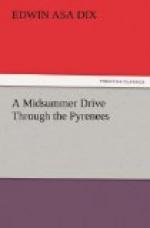A single fine portal of the original sanctuary is still to be seen. But of the old castle not a trace remains; only its name survives,—la Hourquie,—with its significant etymological story: Horcae,—furcae,—– fourches patibulaires,—the gibbet. For these viscounts of Morlaaes had recourse to a savage expedient to control the lawlessness of their day. They kept a gallows-tree erect before the castle gateway, a speaking symbol of vengeance, and there the blackened corpse, might hang until replaced, swinging in the winter wind. There was a mint here also, which stamped the metal of the little realm, and on the coins too appeared the device of the gibbet. There is a tradition that the executions took place only on market-days, and in the Pyrenees to this day the market-gathering is known as the Hourquie.
[Illustration]
* * * * *
Eleven miles west leads us four centuries forward again from Morlaaes. This is Lescar; with its ancient cathedral, the St. Denis of Bearn, the burial-place of generations of its rulers. Morlaaes has been deposed, and Orthez reigns in its stead,—with Lescar as primate. The gleam and glory of chivalry have grown with the years. Here was the seat of the church militant in its strongest manifestation. “The bishops of Lescar,” writes Johnson, satirically, “are said to have been well suited to the times in which they lived; fighting when they could, and cursing when they could not. In the early history of the province, they are found lustily taking a part in the battles of the frontier country; and when peaceful times came, getting up a comfortable trade with the intrusive infidels they had so lately belabored. The reputation for wealth acquired by this astute community seems to have brought its troubles upon the enterprising diocesans, for tradition has it that in the eleventh century Viscount Dax laid sacrilegious hands upon their property. Whether he was too strong for the carnal weapon or spiritual manifestations were deemed more appropriate to his particular case, history does not record, but certain it is that the rebellious noble, being deaf to expostulation, was excommunicated, and resenting that, was seized with a leprosy, of which he died. His successor, adopting the same line of policy as the deceased, was treated in the same way and with the same result. So that between the thunders of the church and the arms of the flesh, the Episcopality of Lescar waxed mightily, and its bishops took the position of premier barons in the province, sitting next to royalty in council and therein keeping to order all grumblers against their rights and privileges. If two of the venerable prelates themselves happened to disagree and logic failed them, then,—it being scarcely orthodox for the reverend men to fight the matter out personally,—they employed a couple of lusty varlets to settle the business for them, and upon the weakest shoulders fell all the consequent disadvantages; thus instituting a simple and expeditious method of cutting short disputes by which the ecclesiastical courts of the present day do not appear to have benefited.”




